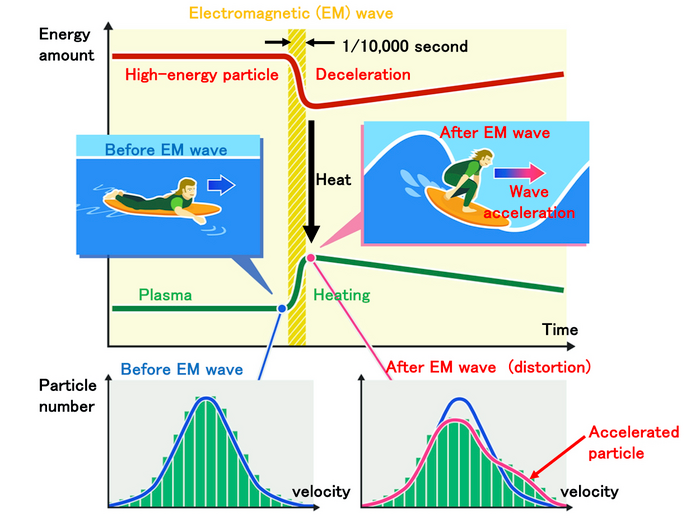It is necessary for fusion power generation that the high-energy particles—produced by a fusion reaction in hot plasma—heat themselves to withstand more fusion reactions. Whether waves generated by the high-energy particles could heat it is the basis to this self-heating of the plasma.
 Heat is carried by electromagnetic waves, which simultaneously slow down the high-speed particle beam (red line) and heat up the plasma particles (green line). Distortion of the velocity distribution is observed due to the acceleration of the particles as a result of the electromagnetic waves. Image Credits: National Institute for Fusion Science
Heat is carried by electromagnetic waves, which simultaneously slow down the high-speed particle beam (red line) and heat up the plasma particles (green line). Distortion of the velocity distribution is observed due to the acceleration of the particles as a result of the electromagnetic waves. Image Credits: National Institute for Fusion Science
A study team headed by Professor Katsumi Ida, Assistant Professors Tatsuya Kobayashi and Mikiro Yoshinuma of the National Institute for Fusion Science and Professor Yuto Kato of Tohoku University has assessed the time difference of the plasma velocity profile in the Large Helical Device (LHD) at the National Institute for Fusion Science.
The team discovered that electromagnetic waves generated by high-energy particles transport heat via a process known as Landau damping. In the domain of this process, this is the first observation. On September 28th, 2022, a paper briefing the findings of this study was published in Communications Physics.
So far, no method was there to directly assess the plasma heating process due to electromagnetic waves produced within the plasma. Therefore, it has been unknown whether this process exists in real.
Professor Katsumi Ida and his study team have worked to create a new measurement system to capture it. To measure the heating process directly, it is essential to find the time difference of the velocity distribution, indicating the existing velocity particles and their proportion.
To this end, the team injected high-speed atoms into the plasma and employed an approach to assess the velocity distribution of plasma particles at high speed from the wavelength distribution of light emitted from the plasma (high-speed charge exchange spectroscopy).
Professor Ida and his coworkers decided to work on the problem of ultra high-speed measurement, which had been regarded as challenging and succeeded in measuring the time difference of the velocity distribution of plasma particles at an ultra high-speed of 10 kHz (10,000 times per second).
In the LHD, experiments are carried out to examine plasma self-heating, using a high-speed particle beam that imitates high-energy particles from nuclear fusion reactions. In such an experiment to imitate self-heating, a recently created measurement system was employed to measure the time difference of the velocity distribution of plasma particles in detail.
Correspondingly, it was found for the first time in the world that the plasma is heated owing to the slowing down of the high-speed particle beam and the distortion of the velocity profile of the plasma particles due to the production of electromagnetic waves within the plasma.
The cause of this distortion of the velocity profile was discovered to be that the high-speed particle beam energy was passed onto the electromagnetic wave via a process known as Landau damping, and the electromagnetic wave energy was passed onto the plasma particles. The research team witnessed the electromagnetic waves passing the high-speed particle beam energy to the plasma and heated it.
For self-heating of plasma in fusion power generation, it is not enough for high-energy particles to collide with plasma ones and heat them, so heating by other processes is also necessary. This result, which shows that electromagnetic waves generated inside the plasma can heat it, provides important knowledge for fusion research. Furthermore, it will contribute to the study of the Earth's magnetosphere, where particle acceleration occurs by a similar process, and will promote future interdisciplinary research.
Katsumi Ida, Professor, National Institute of Fusion Science
Journal Reference
Ida, K., et al. (2022) Direct observation of mass-dependent collisionless energy transfer via Landau and transit-time damping. Communications Physics. doi.org/10.1038/s42005-022-01008-9.